Nexus 7 (2013) - Mini Review
by Brian Klug on July 27, 2013 12:54 AM EST- Posted in
- Tablets
- Snapdragon
- Qualcomm
- Android
- Mobile
- APQ8064
- Nexus 7
- Android 4.3
The real highlight of the new Nexus 7 is of course the much higher resolution display. At 1920x1200 the Nexus 7 is now the highest resolution 7-inch tablet. This new IPS panel is made by JDI (Japan Display Inc) and boasts better viewing angles, 30 percent more gamut than the previous one, and of course better dot pitch of 323 PPI. Alongside that the new Nexus 7 also doesn’t have the always-on dynamic brightness and contrast (NVIDIA Prism / smartdimmer) that many including myself found frustrating with the original Nexus 7. On the new version the equivalent functions are enabled only during full screen video playback. This is a huge improvement since with the feature enabled on the previous Nexus 7 I always felt that greens were undersaturated and some dynamic range clipped.
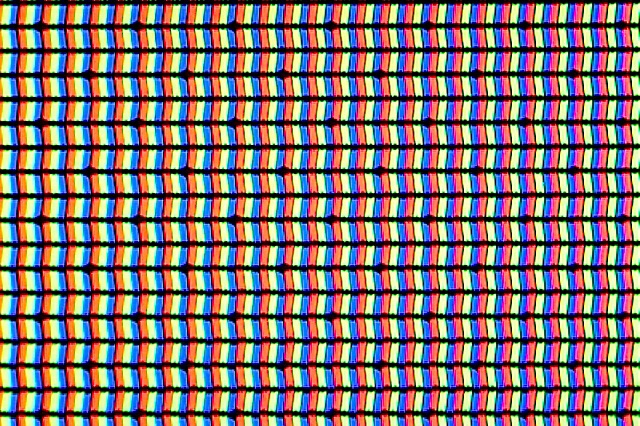
I did a lot of asking around about how Google calibrates its panels, and was told that in the case of the Nexus 7 there are two stages. The first is the calibration done by JDI on the panel at a high level, the second is an additional calibration at time of manufacture, per device. This sort of thing is relatively standard, but I’ve always been curious about what stages cost extra money – certainly it’s a baseline expectation for the panel supplier to supply a close-enough LUT, but getting Delta E even lower I’m told requires additional expenditure.
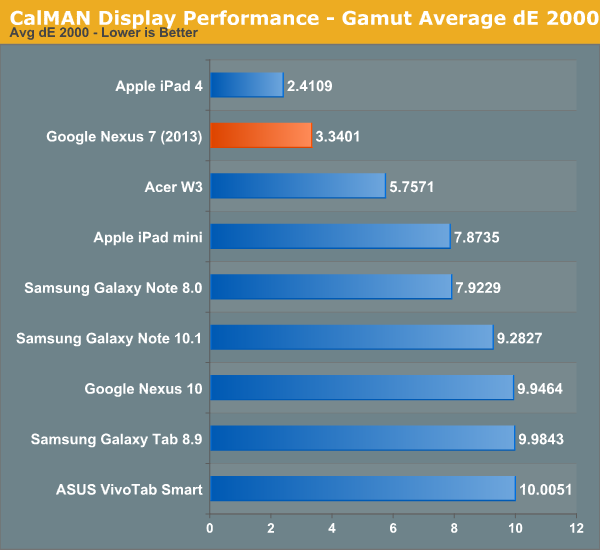
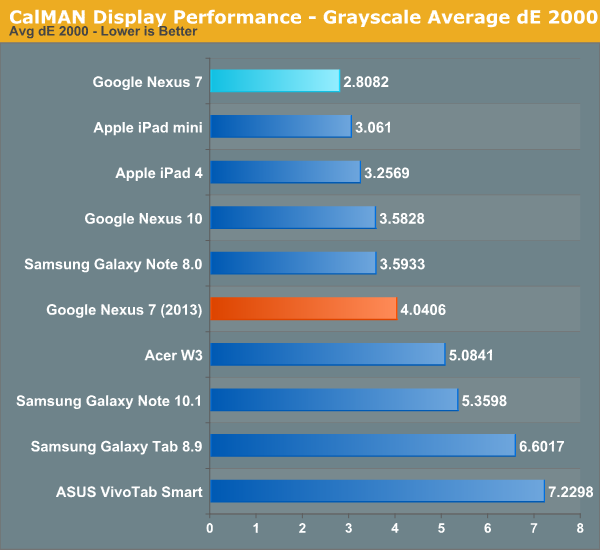
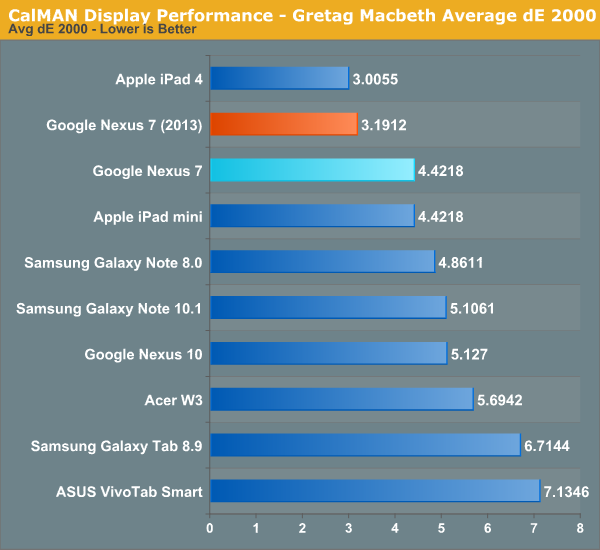
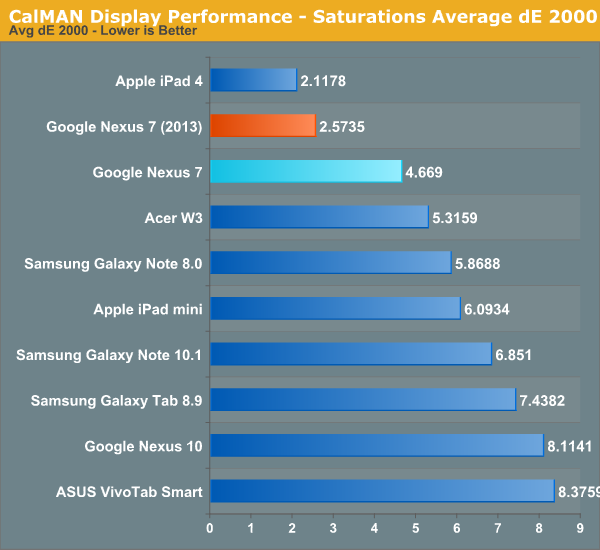
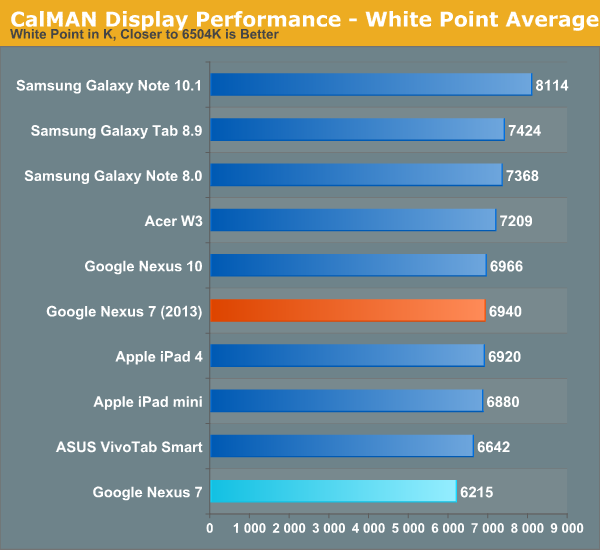
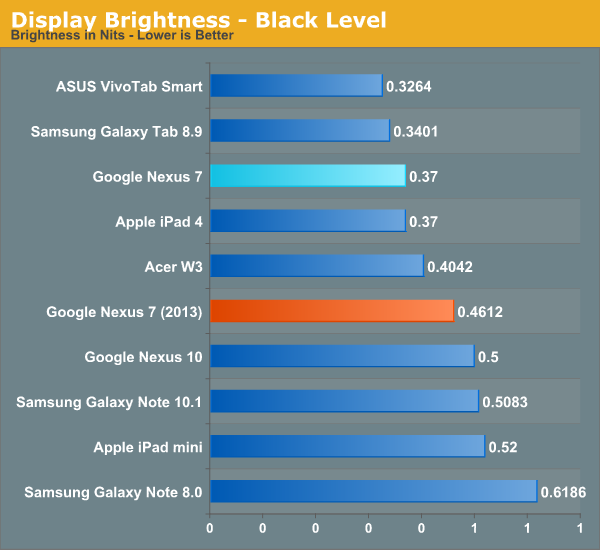
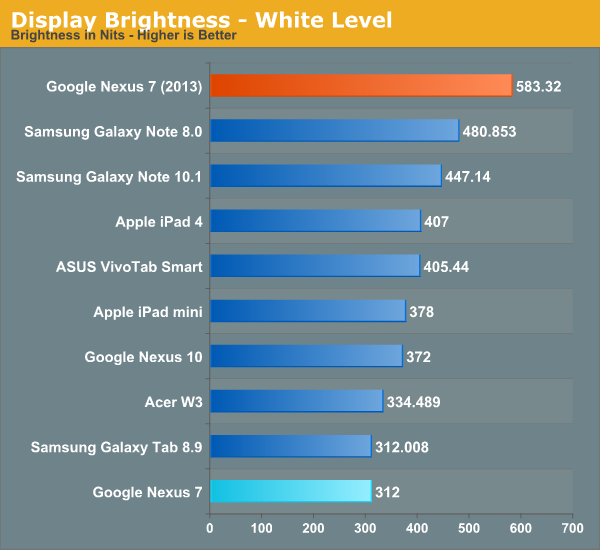
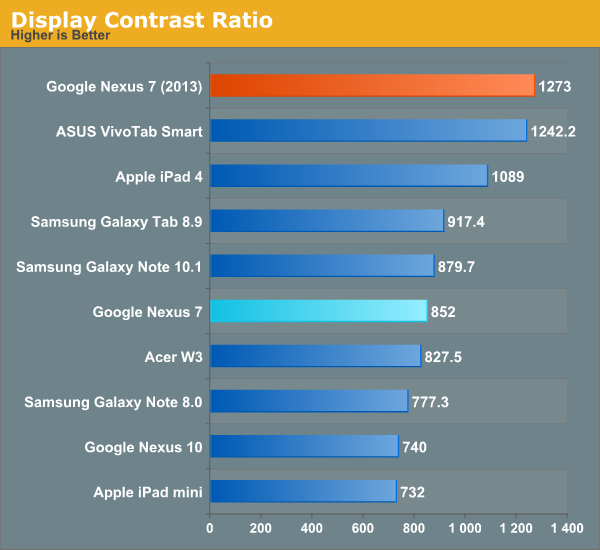
It turns out that the new Nexus 7 is actually very close to sRGB this time around, with overall gamut being just a bit bigger than the sRGB color space. In the GMB Delta-E and saturations Delta-E measures, arguably the two most relevant for color accuracy, the new Nexus 7 is second only to the iPad 4, and better than the iPad Mini in color accuracy, a significant step forwards from its predecessor.
The new Nexus 7 also goes very bright, up to 583 nits, with excellent contrast of 1273. This is again not achieved using any dynamic contrast cheating since those functions are thoughtfully disabled.
On the display side of things I’m very pleased with how far the Nexus 7 has come, and it’s obvious that display quality was a big focus for the 2013 model.















252 Comments
View All Comments
Krysto - Sunday, July 28, 2013 - link
Or maybe you're just not paying attention. They said they sold over 7 million Nexus 7's.abazigal - Sunday, July 28, 2013 - link
Is there any mention of its battery life in real-world tests?kmand - Sunday, July 28, 2013 - link
Does it support NEON? I know the Tegra-3 did.Wombat2013 - Sunday, July 28, 2013 - link
It would be helpful if the upcoming full review would address:- OTG compliance
- Slimport output testing
There have been varying opinions online about whether/how well these features work on the Nexus 7 (2013). (Not surprising - opinions, not AT real testing..)
Written from my new Nexus 7.
bznotins - Sunday, July 28, 2013 - link
Thanks for the great review, Brian. Definitely "mini" in name only and typical of why Anandtech is my most reliable tech review source.On going to hold-out for the LTE version with the hope that it can/will allow me to use it as a mobiles hotspot and replace my TMob Sonic 2.0 LTE hotspot. I know the 4G Nexus 7 stock wasn't capable of operating as a hotspot but I have my fingers crossed for the new LTE version.
Any speculation on a release date? "Weeks" feels pretty nonspecific.
yun - Sunday, July 28, 2013 - link
Pity no Tegra 4, my friend Squall-le am disappoint.kgh00007 - Sunday, July 28, 2013 - link
Hi, what link speed does the new nexus 7 connect with on 2.4 & 5Ghz? The OG nexus 7 only connected at 65Mbps?Cheers!
jojo98 - Sunday, July 28, 2013 - link
When testing WiFi, average throughput is nice but you should measure the variance as well. Even better would be under controlled interference if you have a lab setup to do it. Maybe a time graph vs data rate and latency would be nice.I'd rather have a consistent 20 Mbps connection than 100 Mbps average one that varies a lot in both data rate and latency. These kinds of things will show in voice and video over IP applications where the quality will be reduced when even only a short hit in speed and or latency occurs. Streaming sites like Netflix, Amazon and others will also reduce quality. The low quality will persist for a while even when your WiFi link gets better right after the dip.
MarkP23 - Monday, July 29, 2013 - link
Yes, only testing the average WiFi throughput is like only testing sequential accesses to SSDs when it comes to gauging what real world experience would be like.We need to know how stable the connection is over a prolonged amount of time (how much latency and data rate changes). All too often my WiFi connection blips during a Skype call or video stream causing the app to lower the quality. Even if it's only a momentary blip, most applications' algorithms won't immediately go back to the original quality. It may take minutes or until you reconnect because you can't stand watching blocky video and tinny audio.
bobak - Sunday, July 28, 2013 - link
Whilst AnadTech's articles and reviews are always excellent, the first place I go to read up on devices / components, a simple fact remains.Companies can bring out as many new android phones as they like, high spec, huge screens, packed with features... but they all run android. I tried it, i didn't like it. I tried it again and again and I still absolutely hate it. It feels old, clunky, disjointed, overcomplicated, ugly and not at all intuitive.
I'll be the first to admit, this is entirely based on my personal opinion, however every single person I know who has bought an android phone has turned round to me and asked "how much do you reckon i'll get for this on ebay... i hate it" within the first month.
Great article, i'll keep on reading them and enjoying them, but I just feel android misses the mark by a long shot. I'd rather a Windows phone - at least the OS looks and feels nice.
I'm well aware i'll probably get a load of replies telling me how I'm a fanboy or hater or whatever, but at least I tried to like it with an open mind, several times.